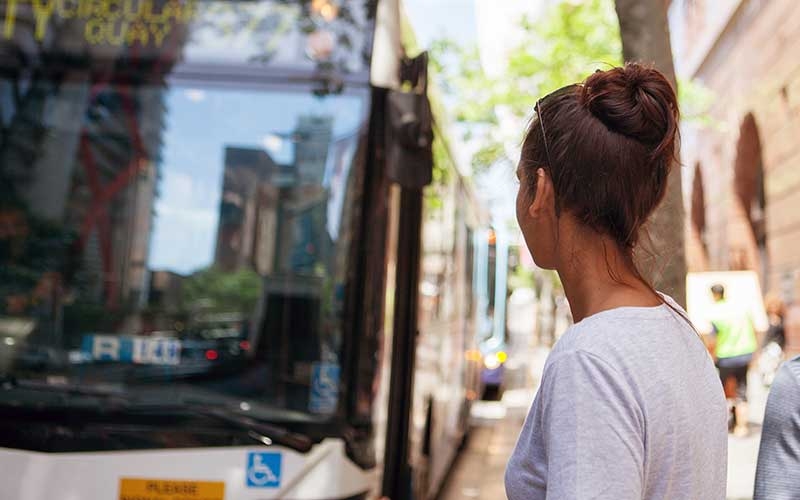Access under Disability Standards for Accessible Public Transport

Introduction
These Guidelines have been developed by the Australian Human Rights Commission (the Commission) to provide clear and practical assistance to facilitate compliance with the Disability Standards for Accessible Public Transport 2002 (Cth) (the Transport Standards) through the use of equivalent access.
These Guidelines are distinct from the Disability Standards for Accessible Public Transport Guidelines 2004 (No. 3) (Cth) (Transport Standards Guidelines), which seek to provide general guidance on the Transport Standards.
The Guidelines provide:
- information about the operation of the federal Disability Discrimination Act 1992 (Cth) (the Disability Discrimination Act) in relation to:
- unlawful disability discrimination in access to premises and the provision of goods, services and facilities
- when discrimination may not be unlawful
- the relationship between the Disability Discrimination Act and the Transport Standards
- information about the operation of the Transport Standards in relation to:
- compliance with the Transport Standards by equivalent access
- when failure to comply with the Transport Standards may not be unlawful
- practical guidance for using equivalent access to comply with the Transport Standards.
These Guidelines do not provide guidance on any other disability standards made under the Disability Discrimination Act or other regulatory instruments relevant to the provision of public transport.
Equal access to the physical environment, transportation and other facilities and services is viewed as a pre-requisite for people with disability to live independently, participate fully in all aspects of life and have unrestricted enjoyment of their human rights.[i] The United Nations Convention on the Rights of Persons with Disabilities (CRPD), which Australia ratified in 2008, requires States Parties to take appropriate measures to ensure people with disability have equal access to the physical environment, to transportation, to information and communications and to other facilities and services open or provided to the public, both in urban and in rural areas.[ii]
The Disability Discrimination Act seeks to eliminate discrimination against people with disability.[iii] The Disability Discrimination Act is supplemented by a series of Disability Standards, which include the Transport Standards.
The Transport Standards aim to enable operators and providers to remove disability discrimination from public transport services.[iv] Compliance with the Transport Standards can be achieved by applying the specifications set out in the Transport Standards or by using methods or equipment that deliver equivalent access. Use of equivalent access:
- potentially offers operators and providers flexibility in the delivery of accessible public transport
- supports innovation by providing an opportunity to harness new technology to improve accessibility
- offers the potential for the delivery of public transport that exceeds minimum published accessibility standards
- encourages communication and collaboration between operators and providers, through required consultation with passengers with disability, organisations representing people with disability and other stakeholders, which may result in long-term access solutions developed through co-design rather than as a result of a complaint or litigation.
1.1 A need for guidance
Operators and providers have previously reported that they would benefit from greater clarity around using the equivalent access provisions in the Transport Standards.[v]
Some operators and providers indicated that they are reluctant to use equivalent access solutions as there is no way to confirm that these solutions comply with the Transport Standards.[vi]
Equivalence of access can only be authoritatively determined if a complaint about access is lodged with the Commission that cannot be conciliated and proceedings are brought in a federal court. In such cases, the provisions will be tested during the process of determining whether or not discrimination has occurred with the Court deciding upon whether equivalent access has been provided. As a result, the flexibility that the provisions give comes with a degree of uncertainty over whether or not alternative forms of access will be found to be equivalent.[vii]
Compliance with the Transport Standards in rural, regional and remote locations appears to be progressing at a slower pace than in urban and metropolitan areas, resulting in frustration and disappointment among people with disability and their representatives.[viii] Some operators and providers have expressed apprehension at the specific challenges these locations present in achieving compliance with the Transport Standards, including low passenger numbers and prohibitive costs.[ix] Operators and providers are more likely to rely on legacy rolling stock and other conveyances (for example, trains procured before the commencement of the Transport Standards or buses purchased from metropolitan operators).
In rural, regional and remote locations fewer staff may also be available to deliver equivalent access by direct assistance. Guidance on the use of equivalent access would assist operators and providers in rural, regional and remote locations to deliver more accessible transport to passengers with disability.
In response to this identified need for clarification and guidance, the Department of Infrastructure, Transport, Regional Development and Communications approached the Commission to develop these Guidelines. While these Guidelines do not provide all of the answers to questions about equivalent access, they draw together existing law and guidance material and provide some frameworks for assessing whether particular proposals satisfy these legal requirements.
1.2 The development of these Guidelines
(a) Process
To develop the Guidelines the Commission conducted a number of targeted consultations. Consultation workshops were held with people with disability and their representatives, representatives of operators and providers of public transport, state and federal government departments responsible for the provision of public transport and related infrastructure, and other related organisations.
An Issues Paper was released to stakeholders in June 2019 and face-to-face consultation workshops were held in Sydney, Melbourne, Darwin and Brisbane in July and August 2019. Some organisations also provided written submissions.
A smaller group of stakeholders, representative of the larger group engaged through consultations, was asked to provide feedback on an earlier draft of these Guidelines. In total, over 40 organisations were represented in consultations (see Appendix 1 for a complete list).
The information gathered during the consultation process is drawn on throughout these Guidelines.
(b) Main themes from the consultations
The two main themes that emerged from the consultations were the importance of equivalent access, and the need for guidance.
During the consultation process the Commission heard that equivalent access offers a potential mechanism to comply with the Transport Standards which promotes flexibility, innovation and cooperation.
‘Equivalent access is an excellent mechanism. Even when Standards are modernised, Equivalent access will still be needed to cover situations, new technology and change not foreseen by a Standard. In that sense, Equivalent access can keep a Standard relevant and capable.’
Submission to the Commission from Spinal Life Australia[x]
However, operators and providers also indicated that uncertainty about how equivalent access provisions are interpreted acts as a disincentive to their use. There was general support for more guidance about equivalent access to assist in increased use.
[i] Convention on the Rights of Persons with Disabilities, opened for signature 30 March 2007, 2515 UNTS 3 (entered into force 3 May 2008) art 9; Committee on the Rights of Persons with Disabilities, General Comment No 2 (2014): Accessibility (Article 9 of the Convention on the Rights of Persons with Disabilities), 11th sess, UN Doc CRPD/C/GC/2 (22 May 2014) paras 1, 13–14.
[ii] Convention on the Rights of Persons with Disabilities, opened for signature 30 March 2007, 2515 UNTS 3 (entered into force 3 May 2008) art 9.
[iii] Disability Discrimination Act 1992 (Cth) s 3.
[iv] Disability Standards for Accessible Public Transport 2002 (Cth) s 1.2(2).
[v] The Allen Consulting Group, Review of the Disability Standards for Accessible Public Transport (Final Report, October 2009) 144.
[vi] The Allen Consulting Group, Review of the Disability Standards for Accessible Public Transport (Final Report, October 2009) 11.
[vii] The Allen Consulting Group, Review of the Disability Standards for Accessible Public Transport (Final Report, October 2009) 143.
[viii] See, for example The Allen Consulting Group, Review of the Disability Standards for Accessible Public Transport (Final Report, October 2009) 8, 12, 14, 18; Australian Government, Department of Infrastructure and Regional Development, Review of the Disability Standards for Accessible Public Transport 2002 (Final Report, July 2015) 18, 31, 166.
[ix] See, for example, The Allen Consulting Group, Review of the Disability Standards for Accessible Public Transport (Final Report, October 2009) 74, 96; Australian Government, Department of Infrastructure and Regional Development, Review of the Disability Standards for Accessible Public Transport 2002 (Final Report, July 2015) 50, 55, 166.
[x] Spinal Life Australia, Submission to the Australian Human Rights Commission, Guidelines: Equivalent Access Under the Disability Standards for Accessible Public Transport 2002 (July 2019) 5.



